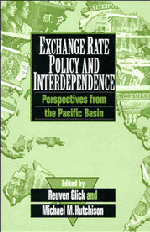Book contents
- Frontmatter
- Contents
- List of contributors
- Preface
- Exchange rate policy and interdependence
- 1 Overview
- I International financial market integration
- II Choice of exchange rate regimes
- 5 Exchange rate management: a partial review
- 6 Exchange rate policy and insulation from external shocks: the cases of Korea and Taiwan, 1970–1990
- 7 Trade price shocks and insulation: Australia's experience with floating rates
- 8 The role of the exchange rate in New Zealand monetary policy
- 9 Officially floating, implicitly targeted exchange rates: examples from the Pacific Basin
- III Intervention and sterilization policies
- IV Prospects for a yen bloc
- Index
6 - Exchange rate policy and insulation from external shocks: the cases of Korea and Taiwan, 1970–1990
Published online by Cambridge University Press: 04 May 2010
- Frontmatter
- Contents
- List of contributors
- Preface
- Exchange rate policy and interdependence
- 1 Overview
- I International financial market integration
- II Choice of exchange rate regimes
- 5 Exchange rate management: a partial review
- 6 Exchange rate policy and insulation from external shocks: the cases of Korea and Taiwan, 1970–1990
- 7 Trade price shocks and insulation: Australia's experience with floating rates
- 8 The role of the exchange rate in New Zealand monetary policy
- 9 Officially floating, implicitly targeted exchange rates: examples from the Pacific Basin
- III Intervention and sterilization policies
- IV Prospects for a yen bloc
- Index
Summary
Introduction
In recent years, growing recognition of the various channels of transmission of external shocks has spurred interest in ascertaining whether a country should peg its exchange rate or allow it to float in response to such shocks. One argument offered in favor of floating is that greater exchange rate flexibility can insulate domestic prices in a small economy from external shocks. For example, under a floating rate regime, a small country can offset inflationary pressures originating from abroad by allowing its exchange rate to appreciate. In general, however, the degree to which flexible exchange rates contribute to the insulation of prices, output, and other domestic economic variables of interest from external shocks cannot be determined a priori. As is apparent from the discussion by Turnovsky in Chapter 5 of this volume, the degree of insulation afforded by flexible exchange rates depends on at least three factors.
First, the extent of insulation under floating is affected by the type of shock. For example, floating exchange rates do not fully insulate against external real shocks, but they may provide complete insulation against external monetary shocks. In the latter case, a purely monetary foreign disturbance that does not affect real interest rates or real output in the long run will also leave the domestic price level unaffected as long as the exchange rate can adjust.
Second, the extent of insulation from external shocks under floating exchange rates depends on the degree of openness of the economy.
- Type
- Chapter
- Information
- Exchange Rate Policy and InterdependencePerspectives from the Pacific Basin, pp. 138 - 158Publisher: Cambridge University PressPrint publication year: 1994
- 2
- Cited by



